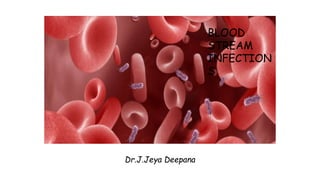blood stream infections in microbiology CBME curriculum
•Download as PPTX, PDF•
0 likes•5 views
This ppt is dealt with types of bacteremia and discuss with the fever of unknown origin ,how to draw blood for blood culture
Report
Share
Report
Share

Recommended
Recommended
More Related Content
Similar to blood stream infections in microbiology CBME curriculum
Similar to blood stream infections in microbiology CBME curriculum (20)
Approach to Sepsis & Septic Shock in Emergency Medicine.

Approach to Sepsis & Septic Shock in Emergency Medicine.
Gi & hepatic complications of solid organ transplantation

Gi & hepatic complications of solid organ transplantation
Dengue in pregnancy by dr alka mukherjee nagpur m.s. india

Dengue in pregnancy by dr alka mukherjee nagpur m.s. india
Recently uploaded
Making communications land - Are they received and understood as intended? webinar
Thursday 2 May 2024
A joint webinar created by the APM Enabling Change and APM People Interest Networks, this is the third of our three part series on Making Communications Land.
presented by
Ian Cribbes, Director, IMC&T Ltd
@cribbesheet
The link to the write up page and resources of this webinar:
https://www.apm.org.uk/news/making-communications-land-are-they-received-and-understood-as-intended-webinar/
Content description:
How do we ensure that what we have communicated was received and understood as we intended and how do we course correct if it has not.Making communications land - Are they received and understood as intended? we...

Making communications land - Are they received and understood as intended? we...Association for Project Management
Recently uploaded (20)
UGC NET Paper 1 Mathematical Reasoning & Aptitude.pdf

UGC NET Paper 1 Mathematical Reasoning & Aptitude.pdf
Mixin Classes in Odoo 17 How to Extend Models Using Mixin Classes

Mixin Classes in Odoo 17 How to Extend Models Using Mixin Classes
Python Notes for mca i year students osmania university.docx

Python Notes for mca i year students osmania university.docx
Russian Escort Service in Delhi 11k Hotel Foreigner Russian Call Girls in Delhi

Russian Escort Service in Delhi 11k Hotel Foreigner Russian Call Girls in Delhi
Making communications land - Are they received and understood as intended? we...

Making communications land - Are they received and understood as intended? we...
Food safety_Challenges food safety laboratories_.pdf

Food safety_Challenges food safety laboratories_.pdf
ICT Role in 21st Century Education & its Challenges.pptx

ICT Role in 21st Century Education & its Challenges.pptx
blood stream infections in microbiology CBME curriculum
- 2. Types of Bacteremia • Bacteremia may be • transient, • continuous, • or intermittent.
- 7. Types of Bloodstream Infections • Factors that contribute to the initiation of BSI are: • Immunosuppression • Use of broad spectrum antimicrobial agents • Invasive procedures or extensive surgeries that allow the bacteria to access the blood • Prolonged survival of debilitated patients
- 8. Extravascular Bloodstream Infections • The organisms multiply at the primary site such as lungs and are drained by lymphatics and reach the bloodstream • The organisms are either removed by the cells of the reticuloendothelial system or they multiply more widely and thereby causing septicemia
- 9. Portal of entry • The most common portals of entry for bacteremia are the genitourinary tract (25%), • followed by respiratory tract (20%), • abscesses (10%), • surgical site wound infections (5%), • biliary tract (5%
- 11. • Sepsis Sepsis is defined as life-threatening organ dysfunction caused by a dysregulated host response to infection • SOFA score • Sepsis is diagnosed by SOFA (Sepsis-related organ failure assessment) score which in turn depends on six parameters. • 1. Respiratory system—PaO2 /FiO2 • 2. Coagulation system—Platelet count
- 12. • 3. Liver—Serum bilirubin • 4. Cardiovascular—Mean arterial pressure (MAP) • 5. Central nervous system—Glasgow coma scale score • 6. Renal—Serum creatinine and urine output • Organ dysfunction can be identified as an acute change in the total SOFA score ≥2 points following the infection
- 13. qSOFA (Quick SOFA) Respiratory rate ≥22/min Altered mentation Systolic blood pressure ≤100 mm Hg
- 14. Septic shock • It is a subset of sepsis in which underlying circulatory and cellular/ metabolic abnormalities are profound • Patients with septic shock can be identified with a clinical construct of sepsis with: • Persisting hypotension requiring vasopressors to maintain MAP (mean arterial pressure) ≥65 mm Hg and • Serum lactate level >2 mmol/L (18 mg/dL) despite adequate volume resuscitation • Patients with septic shock have a mortality of >40% in contrast to 10%, for sepsis cases
- 15. FEVER OF UNKNOWN ORIGIN (FUO) 1. Fever ≥38.3°C (≥101°F) on at least two occasions 2.Duration of illness of ≥3 weeks 3. No known immunocompromised state 4. Diagnosis that remains uncertain after a thorough history-taking, physical examination, and the following obligatory investigations
- 16. • ESR and CRP (C-reactive protein) level • Platelet count, leukocyte count (total and differential), and hemoglobin • Electrolytes, creatinine, total protein, ferritin and protein electrophoresis • Enzymes such as alkaline phosphatase, alanine aminotransferase, aspartate aminotransferase, lactate dehydrogenase, creatine kinase • Antinuclear antibodies, and rheumatoid factor
- 17. • Urinalysis Culture: blood cultures (3 negative cultures) and urine culture • Radiology: Chest X-ray, abdominal USG • Tuberculin skin test or interferon γ release assay
- 18. Etiology of FUO • FUO has both infectious and non-infectious etiology. • Infections (36%): This accounts for majority of FUO cases.
- 19. • Neoplasms (19%): For example, lymphoma, leukemia, myeloma, renal, colon and liver cancers, etc. • Non-infectious Inflammatory Diseases (19%): For example, connective tissue disorders like rheumatoid arthritis, SLE (systemic lupus erythematosus), etc. • Miscellaneous Causes (19%): • Granulomatous diseases • Inherited and metabolic diseases • Thermoregulatory disorders. • Undiagnosed cases (7%).
- 23. 0